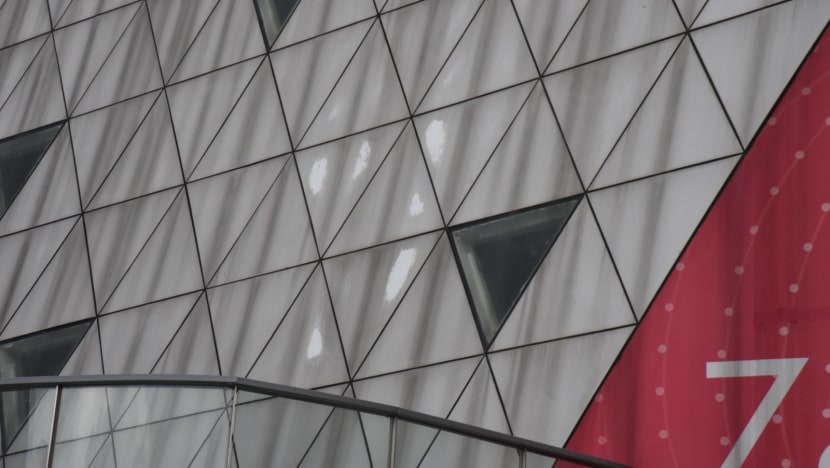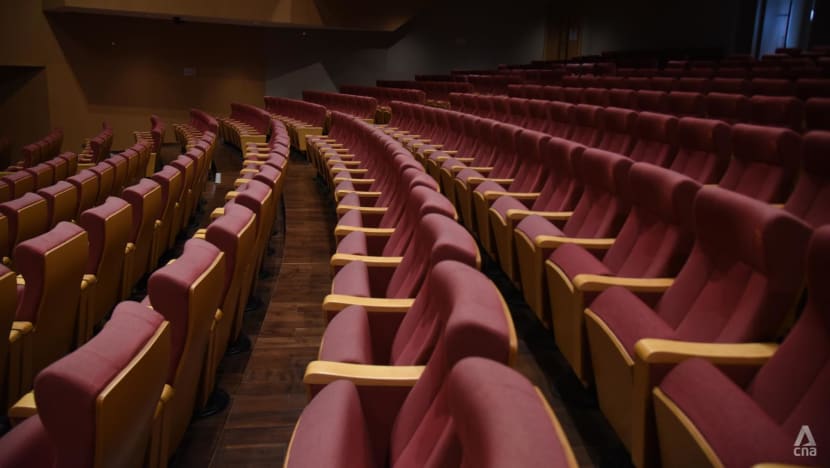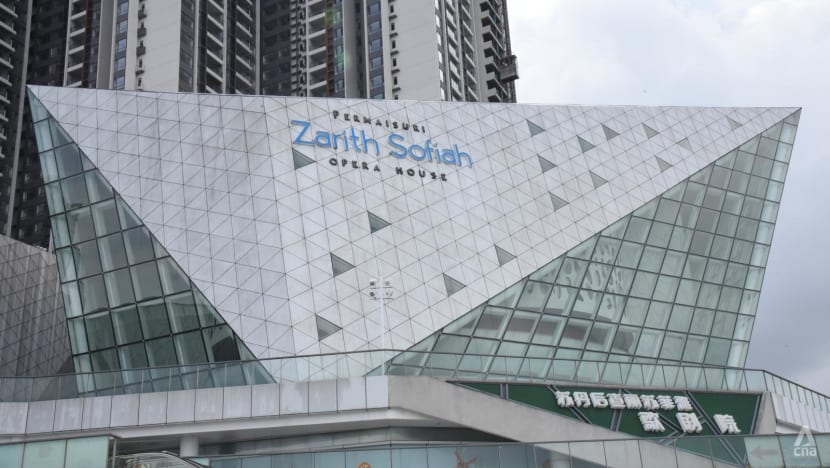Can Johor Bahru's iconic opera house ignite the city's cultural life?
The Permaisuri Zarith Sofiah Opera House was once mooted as a potential cultural hub in Johor. However, performances at the venue have received mixed responses since its reopening post COVID-19.

The Permaisuri Zarith Sofiah Opera House opened in January 2020. It did not host any major shows for most of its first two years due to the COVID-19 pandemic. (Photo: CNA/Amir Yusof)
JOHOR BAHRU: Each time IT engineer Paul Teo travels across the Woodlands Causeway for his daily work commute, he would glance at the building overlooking the Johor waterfront he described as a “sparkling cluster of diamonds”.
“The architecture is quite impressive, unlike anything I’ve seen in the humble town of Johor Bahru. The design reminds me a bit of museums and buildings you see in Europe,” said the 34-year-old Malaysian.
“But it's a shame, I have never actually seen what it looks like from the inside or bought tickets for any of its shows,” added Teo.
The building - the Permaisuri Zarith Sofiah Opera House - has a distinctive jewel-shaped facade and faces one of the busiest land-border crossings in the world.
However, in spite of the opera house’s impressive architecture and visible location, some industry observers told CNA it has not garnered sufficient popularity and attention to fulfill its potential as a key cultural hub in Johor Bahru.
The opera house is named after the wife of Johor’s ruler Sultan Ibrahim Sultan Iskandar - Raja Zarith Sofiah Sultan Idris Shah.
It sits as part of the residential development project dubbed the R&F Princess Cove, which constitutes high-rise condominium complexes, a yacht club and a retail shopping mall. R&F Group is a Chinese real estate company headquartered in Guangzhou.

The opera house itself is built across 114,430 square feet of reclaimed land. Its main performance hall encompasses 600 seats.
The venue opened to much fanfare in January 2020, with dazzling fireworks display in a ceremony in which Sultan Ibrahim was the guest of honour.
However, due to COVID-19, the venue was unable to host performances for most of its first two years.
It was only in the beginning of 2023 that it began to offer classical music performances, cultural shows as well as stand-up comedies.
As the venue continues to rev up its offerings, observers have questioned whether it will be able to attract visitors amid concerns that its small size might be a deterrent to get more established acts.
TICKET SALES INCREASING STEADILY: R&F GROUP
Geoffrey Xie, the vice-general manager for R&F Group Malaysia, said in an interview with CNA that reception for the performances at the opera house have been “encouraging” in 2023.
“We are happy because ticket sales have been increasing steadily. But of course there is room for improvement. More can be done to spread the word to Johoreans and Singaporean visitors that the opera house is not just a beautiful building but it also has great shows,” said Xie.
Xie outlined that a show at the opera house which received good response was a stand-up performance by Malaysian comedian Jason Leong in June which he said was fully sold out.
Leong is a popular local celebrity with two Netflix specials.
He added that R&F Group was looking to add more of such shows to its line-up. He said that the team is working to bring in Singaporean comedian Kumar in the latter half of 2023 for a show.
“We hope that more people will come for these stand-up shows, and after they visit the opera house, they will come back again for more performances - like classical music, and traditional shows like Drum Up,” said Xie.
One cultural heritage show which has become a constant bimonthly fixture at the Permaisuri Zarith Sofiah Opera House is percussion ensemble “Drum Up JB!”.
The show features the theme 24 Festive Drums - a performance that originated from Johor Bahru which represents the 24 festivals in the lunar calendar of the Chinese agricultural community.

The performance’s co-producer Lee Sheah Liang told CNA that settling on the Zarith Sofiah Opera House as a performance venue was a natural choice due to the fact it is an “iconic cultural arts venue” in Johor Bahru.
“We thought that it was a timely opportunity to do it - hosting a cultural performance with Johor origins at the first opera house in Johor Bahru,” said Lee.
“The location is also a big draw, it is right at the border between Johor and Singapore. It’s right at the main door of Johor Bahru and every vehicle or person travelling in can see this building. Many Singaporean visitors are interested and they form a sizable portion of our audiences when we perform,” he added.

Across the first six performances between January and March earlier this year, Lee said that reception for their shows were “overwhelming” with 90 to 100 per cent of the tickets being sold.
He acknowledged that ticket sales have since tapered to around 50 to 80 per cent in subsequent months, but Lee maintained that this was not unexpected for a long-running performance.
PLAGUED BY FACADE ISSUES, SMALL CAPACITY
The opera house has also garnered criticism from certain quarters in recent months.
In an online article published in April, local news outlet New Straits Times reported that the Permaisuri Zarith Sofiah Opera House had become an “eyesore” as the building’s exterior was visibly dirty due to the accumulation of dirt and grime.
The report quoted R&F Group chairman Li Mingliang as saying that black adhesive used to secure the metal cladding to the building's exterior surfaces had left black residue on its facade.

He also reportedly said that the firm was looking for a “reliable cleaning contractor” to resolve the issue.
When CNA visited the development in mid-July, the glass facade of the main opera house building seemed clean and polished. However, some of the adjacent buildings which houses the ticket office and promenade were still visibly dirty.
R&F’s Xie told CNA that the cleaning process had started but was still not yet completed due to the extensive dirt which had accumulated over the years.
“The opera house is facing the Causeway where thousands of vehicles travel across each day. There is inevitable smog and pollution so the building’s facade is affected,” said Xie.
“We are committed to do the cleaning once every four months, even though it is an expensive undertaking,” he added.

Lee of Drum Up JB! stressed that it was important that the facade issue is resolved as the outward appearance of the opera house is key to attracting more visitors in the long term.
“There is still some fine tuning to be done. We are aware of the negative points, such as the issues relating to the building’s facade,” said Lee.
“We cannot shove these issues under the carpet and are pushing R&F to rectify them,” he added.
In addition, some observers have also questioned the long-term financial viability of the opera house given that its seating capacity of 600 is relatively small compared to other art and cultural theatre venues in Singapore and Kuala Lumpur.

Cultural expert Joe Sidek, who is the founding director of the George Town Festival in Penang, told CNA that he “thoroughly enjoyed'' his experience at the opera house in April when he watched the Drum Up JB! Performance.
However, he expressed concern that the small capacity of the Permaisuri Zarith Sofiah Opera House would make it difficult for performances with large manpower to break even financially.
“It’s really a lovely little opera house, nice building and great views of the sea and the Causeway,” said Joe.
“But from the commercial side of things, it’s not so easy. Can you imagine, if there are around 20-30 people in your performing team and you have so many people to pay? The maths is not right,” he added.
Joe explained that having a 600-capacity venue will hold back the opera house from hosting larger scale events like concerts featuring world renowned artists, keeping in mind the likes of Coldplay and Taylor Swift have recently favoured Singapore’s Sports Hub 55,000 capacity venue for consecutive-days performances over other options in the region.
However he acknowledged that in the case of the Permaisuri Zarith Sofiah Opera House, garnering profits through large-scale events was never R&F’s main objective.
“The idea is to enjoy the multiplier effect, offer these events to draw tourists who will come to Johor Bahru, eat at the restaurants, stay at the hotels and attract more footfall in that manner,” said Joe.
“But doing (large-scale) events is not (R&F Group’s) core business,” he added, noting that the company’s focus is on residential and retail property.

R&F’s Xie was also pragmatic over the limitations of the opera house.
“I don’t think we will host a Jay Chou concert anytime soon. But we are trying our best to attract more visitors, including the non-Chinese population to visit and enjoy our performances,” added Xie.
He said that the majority of the Johor population are Malays, and offering performances which are attractive to not just the Chinese audience would be a bonus in the short term.
Joe, the cultural expert, told CNA that such initiatives should be applauded, and opined that the venue should also offer programmes that feature Malay Johorean culture.
“Johor is part of the Riau archipelago so the Malay narrative is strong. Singapore has a Malay Heritage Centre and interesting programmes and shows but Johor, which has an even richer Malay history has not been able to do the same,” said Joe.
“Johor has got all the right ingredients - talent, space, opportunity. I’m sure they can do it,” he added.


















